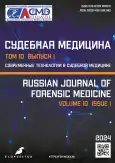芯片植入和DNA鉴定技术在未成年人识别过程中的应用: 科学综述
- 作者: Doszhanova A.B.1, Begaliyev Y.N.1, Kurmangali Z.K.2, Imashev B.M.3
-
隶属关系:
- Academy of Law Enforcement Agencies Under the General Prosecutors Office of the Republic of Kazakhstan
- Department of Internal Medicine of the Corporate Fund University Medical Center
- Eurasian Center for Economic and Legal Studies of Narxoz University
- 期: 卷 10, 编号 1 (2024)
- 页面: 79-87
- 栏目: 科学评论
- URL: https://journals.rcsi.science/2411-8729/article/view/254429
- DOI: https://doi.org/10.17816/fm16095
- ID: 254429
如何引用文章
全文:
详细
本文考虑使用芯片植入和DNA鉴定等未成年罪犯识别技术的可能性。芯片植入技术需要在安全和尊重儿童隐私之间找到平衡。使用较新的基因技术更有前途。DNA数据库的创建有助于改进执法机构工作,特别是增加识别罪犯身份的可能性。然而,由于种种原因,收集未成年人的遗传物质是困难的,这就需要找到克服这些困难的方法。
为了研究在哈萨克斯坦共和国使用信息和通信技术识别未成年罪犯的问题和前景,作者采用了比较法律分析法。该分析有助于揭示应用芯片植入和基因组识别的可能性。目前,哈萨克斯坦社会拒绝对人体内植入芯片,更不用说对儿童体内植入芯片。因此,在就这一技术做出决定之前,必须考虑到所有方面并仔细分析可能产生的后果。
如今,共和国执法机构的活动离不开信息技术。为改善这一进程,有必要开发新的现代个人身份识别系统,并建立生物特征参数数据库。对未成年人使用任何形式的芯片植入技术(将芯片植入皮下或缝入校服)的主要障碍是法律规定和道德障碍。与此同时,独特的生物识别技术,DNA鉴定,在识别公民(包括未成年人)身份方面有许多明显的优势。在这方面,有必要对国家生物识别登记进行统一的立法规范。
对各种技术进行比较分析后得出的结论是,在现阶段,DNA鉴定是一种更有前途、更规范的程序。为此,在识别定未成年人身份的过程中,为使用这种方法提出了一些可能的方向。
作者简介
Aitolkyn B. Doszhanova
Academy of Law Enforcement Agencies Under the General Prosecutors Office of the Republic of Kazakhstan
编辑信件的主要联系方式.
Email: aitok82@mail.ru
ORCID iD: 0009-0007-3257-6601
哈萨克斯坦, Koshy
Yernar N. Begaliyev
Academy of Law Enforcement Agencies Under the General Prosecutors Office of the Republic of Kazakhstan
Email: ernar-begaliev@mail.ru
ORCID iD: 0000-0001-6659-8576
SPIN 代码: 4397-7648
Dr. Sci. (Legal), Professor
哈萨克斯坦, KoshyZhanar K. Kurmangali
Department of Internal Medicine of the Corporate Fund University Medical Center
Email: zhanar.k.kurmangali@gmail.com
ORCID iD: 0000-0001-9380-3432
SPIN 代码: 7987-3742
MD, Dr. Sci. (Med.)
哈萨克斯坦, AstanaBerik M. Imashev
Eurasian Center for Economic and Legal Studies of Narxoz University
Email: berikmazhitovich@gmail.com
ORCID iD: 0009-0001-8760-9913
SPIN 代码: 4888-0942
Cand. Sci. (Legal)
哈萨克斯坦, Almaty参考
- Weber K. Privacy invasions: New technology that can identify anyone anywhere challenges how we balance individuals' privacy against public goals. EMBO Rep. 2006;7(S1):36-39. doi: 10.1038/sj.embor.7400684
- Alikperov HD. Global remote crime control: acceptability, opportunities, costs. Criminology: yesterday, today, tomorrow. 2016;(3):26-33. (In Russ). EDN: WWRTDB
- Wang Y. A review of microchip implant in human. In book: Proceedings of the 2022 6th International Seminar on Education, Management and Social Sciences (ISEMSS 2022). 2022. P. 92-97. doi: 10.2991/978-2-494069-31-2_12
- Tursunov AB, Galitsky FA, Begaliev EN, et al. Forensic and forensic aspects of childhood traumatism as a result of domestic injuries and traffic accidents: A review. Russ J Forensic Med. 2023;9(3):299-308. EDN: ORUBFH doi: 10.17816/fm12389
- Voyevodkin DV, Rustemova GR, Begaliyev YN, et al. Identifying fake conclusions of forensic medical examinations using an artificial intelligence technology based on the experience in the Republic of Kazakhstan: A review. Russ J Forensic Med. 2023;9(3):287-298. EDN: EFNJIE doi: 10.17816/fm8270
- Orakbayev AB, Kurmangali ZhK, Begaliyev YeN, et al. ON The issue of using the results of a virtual autopsy in criminal investigation: A review. Russ J Forensic Med. 2023;9(2):183-192. EDN: OEERGD doi: 10.17816/fm774
- Kurskaya SA. Obligatory state genome registration in contradiction with the constitutional right to privacy. State power and local self-government. 2023;(7):3-6. EDN: DFZJYH doi: 10.18572/1813-1247-2023-7-3-6
- Zhoga EYu, Vasenin AYu, Varchenko IA. The role of state genomic registration in the prevention, detection and investigation of crime. Humanities, social-economic and social sciences. 2017;(6-7):117-121. (In Russ). EDN: ZEGEWX
- Mashkov SA, Ogorodnikova AV. On the meaning of a dna analysis and genome registration. Ekspert-kriminalist. 2021;(1):26-28. EDN: OLAXSZ doi: 10.18572/2072-442X-2021-1-26-28








